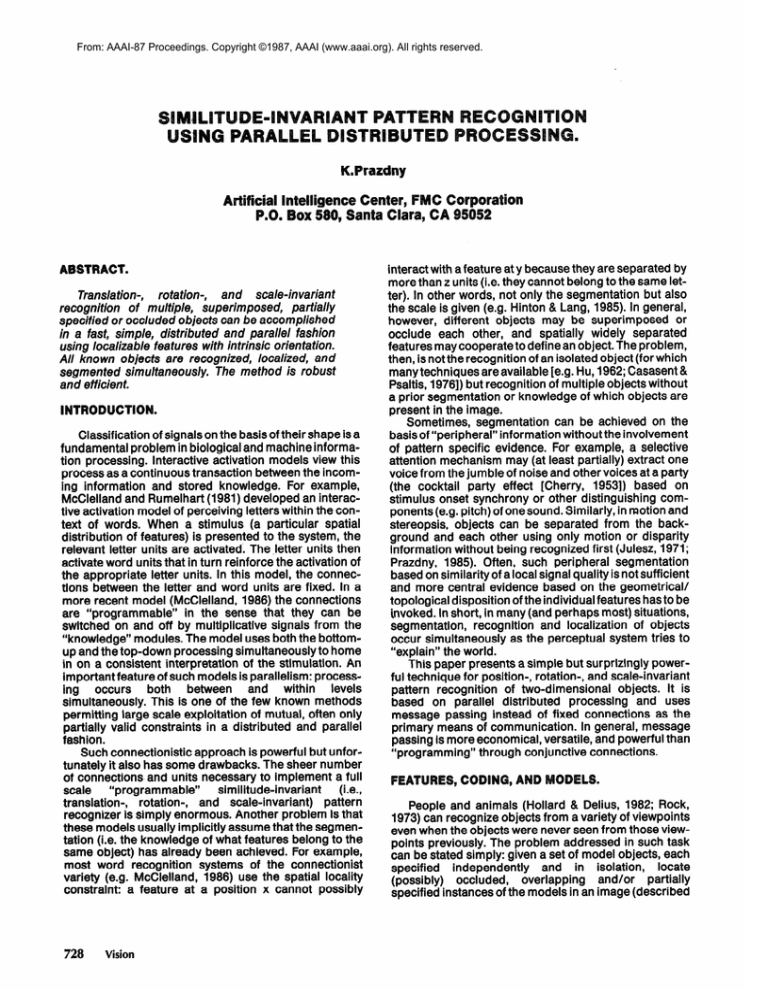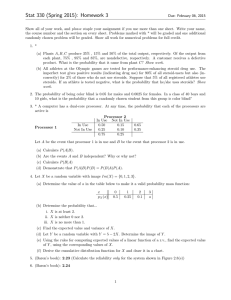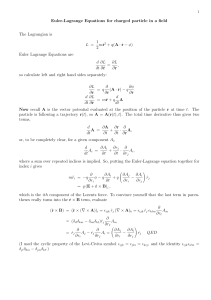
From: AAAI-87 Proceedings. Copyright ©1987, AAAI (www.aaai.org). All rights reserved.
K.Prazdny
Translation-,
rotation-,
and scale-invariant
recognition of multiple, superimposed, partially
specified or occluded objects can be accomplished
in a fast, simple, distributed and parallel fashion
using localizable features with intrinsic orientation.
All known objects are recognized, localized, and
segmented simultaneously. The method is robust
and efficient.
Classification of signals on the basis of their shape is a
fundamental problem in biological and machine information processing. Interactive activation models view this
process as a continuous transaction between the incoming information and stored knowledge. For example,
McClelland and Rumelhart (1981) developed an interactive activation model of perceiving letters within the context of words. When a stimulus (a particular spatial
distribution of features) is presented to the system, the
relevant letter units are activated. The Jetter units then
activate word units that in turn reinforce the activation of
the appropriate letter units. In this model, the connections between the letter and word units are fixed. In a
more recent model (McClelland, 1986) the connections
are “programmable” in the sense that they can be
switched on and off by multiplicative signals from the
“knowledge” modules. The model uses both the bottomup and the top-down processing simultaneously to home
in on a consistent interpretation of the stimulation. An
important feature of such models is parallelism: processing occurs both between and within levels
simultaneously. This is one of the few known methods
permitting large scale exploitation of mutual, often only
partially valid constraints in a distributed and parallel
fashion.
Such connectionistic approach is powerful but unfortunately it also has some drawbacks. The sheer number
of connections and units necessary to implement a full
similitude-invariant
(i.e.,
“programmable”
scale
translation-, rotation-, and scale-invariant) pattern
recognizer is simply enormous. Another problem is that
these models usually implicitly assume that the segmentation (i.e. the knowledge of what features belong to the
same object) has already been achieved. For example,
most word recognition systems of the connectionist
variety (e.g. McClelland, 1986) use the spatial locality
constraint: a feature at a position x cannot possibly
728
Vision
interact with a feature at y because they are separated by
more than z units (i.e. they cannot belong to the same letter). In other words, not only the segmentation but also
the scale is given (e.g. Hinton 81Lang, 1985). In general,
however, different objects may be superimposed or
occlude each other, and spatially widely separated
features may cooperate to define an object. The problem,
then, is not the recognition of an isolated object (for which
many techniques are available [e.g. Hu, 1962; Casasent &
Psaltis, 19761) but recognition of multiple objects without
a prior segmentation or knowledge of which objects are
present in the image.
Sometimes, segmentation can be achieved on the
basis of “peripheral” information without the involvement
of pattern specific evidence. For example, a selective
attention mechanism may (at least partially) extract one
voice from the jumble of noise and other voices at a party
(the cocktail party effect [Cherry, 19531) based on
stimulus onset synchrony or other distinguishing components(e.g. pitch) of onesound. Similarly, in motion and
stereopsis, objects oan be separated from the background and each other using only motion or disparity
information without being recognized first (Julesz, 1971;
Prazdny, 1965). Often, such peripheral segmentation
based on similarity of a local signal quality is not sufficient
and more central evidence based on the geometrical/
topological disposition of the individual features has to be
invoked. In short, in many (and perhaps most) situations,
segmentation, recognition and localization of objects
occur simultaneously as the perceptual system tries to
“explain” the world.
This paper presents a simple but surprizingly powerful technique for position-, rotation-, and scale-invariant
pattern recognition of two-dimensional objects. It is
based on parallel distributed processing and uses
message passing instead of fixed connections as the
primary means of communication. In general, message
passing is more economical, versatile, and powerful than
“programming” through conjunctive connections.
FE
LS.
People and animals (Hollard & Delius, 1982; Rock,
1973) can recognize objects from a variety of viewpoints
even when the objects were never seen from those viewpoints previously. The problem addressed in such task
can be stated simply: given a set of model objects, each
specified independently and in isolation, locate
(possibly) occluded, overlapping and/or partially
specified instances of the models in an image (described
Given such encoding, the recognition process is surprizingly simple mainly because the relational specification does not involve absolute locations or angles (i.e. the
relational coding takes care of the position and rotation
invariance). First, image features are extracted. Each feature is associated with a processor or unit that can send
to, and accept messages from all other feature processors. Each processor, i, has also access to the
knowledge sources (the model catalogue) and can determine a set of admissible correspondences{cijkj between
itself and the model features. A model is instantiated
when a match Cijk is found that maps an image feature
(processor) i to a feature j of model k. Two features match
if they are of the same type (e.g., both are a corner) and
have approximately the same value (in our implementation, the image and model corner angles have to be within
x degrees of each other, where x is a user defined
Each putative correspondence
parameter).
Cijk
immediately allows the demployment of the knowledge
because each model contains information about all other
object features relative to the local reference frame of the
model feature j. Thus, each Ci’k results in a Set of
messages being broadcast (FIGURE 2a). Each direction
can be thought of as priming or gating signals along
which information is propagated that can be “digested”
only byspecific“receptors”within its path. Each message
stipulates exactly which feature with what orientation is
expected at each direction; features outside the “attention” beams are ignored (this is in many ways analogous
to an expectation driven parsing). This is a very general
way to obtain programmable “connections” not available
in the contemporary connectionist schemes. Connections are not fixed but rather generated “on the fly”. It is
similar in many ways to the earlier proposals of Waltz
(1978).
A message is accepted by a processor if the feature
type, value, and direction specified by the message agree
with the processor’s feature specification. When a
message is accepted it is in effect a vote for a particular
correspondence c&c of the feature processor a that
accepted the message. It can be thought of as arguing:
“the sender of this message says that if you accept this
then you are feature b of model c”. Accepting a message
also immediately defines the scale of the object relative to
the model: the scale is simply the ratio of the original
model distance to the signalled distance between the
sender and the receiver.
Each processor i monitors the support for all feasible
correspondences Cijk. After accepting all relevant
messages and updating its state accordingly it chooses
that C*ijk (and the associated scale s*ijk) with the largest
support asthe “correct” correspondence. All subsequent
messages are sent only on the basis of this best
“hypothesized” correspondence C*ijk (this is a “winnertakes-all” computation). The knowledge of the “correct”
scale s*ijk enables the transmitting processor to considerably narrow the message target area: instead of the
“attention beams” small regions around the predicted
locations are used (FIGURE 2b). That is, the first iteration
uses the “attention beams” for message propagation
while all subsequent iteration use the more refined
730
Vision
FlGURE
2.
Messages generated by the correct feature-to-model
correspondence. Each admissible correspondence, Cijk, between an image feature i and a feature j of model k generates a
set of messages along directions determined by the local
reference frame imposed by the image feature i and the relative directions of all other features of the object k with respect
to the feature j. Each message in effect says: “if the image feature i (oriented along angle a) is the feature j of model k then
the feature x of the same model (which lies at an angle p relative to j) has to lie somewhere along a + p.” Each message,
denoted by a small angle in the figure, can be caught only by a
processor whose feature is sufficiently similar (in type, value,
and orientation) to the message specification. An “attention”
beam (instead of a single radial) centered at the predicted
direction is used to overcome various forms of noise
(measurement errors and deformations).
When the scale is known the message delivery area can
considerably narrowed to a region around the predicted
feature location. The message specification (the type/value
pair and the feature direction) is denoted by the thick
lines.
estimates based on the knowledge of s*i’k and the model
distance, d*iak between i and a under k. f he radius of the
message area is proportional to the distance between the
centre of the target area and the sender. This is like sending a message with a delayed “fuse” that “explodes” in a
“fireball” some time after its launch as opposed to one
that is continuously active. Each processor thus
simultaneously and continuously sends and receives
messages, and updates its “beliefs” about the “correct”
image-to-model feature correspondence based on the
information supplied by the other features. After only a
few such iterations a global order emerges due to mutual
“coercion”; the “conspiracy of partial evidence” drives
the system to a stable state (i.e. the state where, for all
(FIGURE 3). In our experiments
We
i, C*ijk(t) = C*ijk(t-1))
have found that in general, no more than three iterations
are required; mostly, the first pass already results in a
correct assignment. The mutual support the features
belonging to the same object provide to each other is also
reminiscent of the concept of synergistic reverberations.
FIGURE 3.
The final state of the system. The models (thick lines denote
model features) are superimposed on the image. Numbers
identify the models (10 models were in the catalogue in this
experiment).
Circles around the features identify the
features of the same object. The lower right polygon (image
features 14-19) has not been recognized, segmented or
localized since no model in the catalogue was supported by
the spatial distribution of those image features.
Assume that ea6h image feature matches, on the
average, n features of m models, and that each model
has, on the average, p features. Then, each feature processor generates, on the average, mnp messages. Only a
small fraction of such messages is actually accepted by
the image feature processors. The computations inside
each processor are very simple. The feasibility of the
algorithm is thus mainly determined by the speed and
costs associated with message broadcastin
The parallel distributed approach described above is
fast and robust: if there are features that are mutualiyconsistent under some mapping to the same model, they will
support each other and survive. The approach leaves one
additional problem to solve, however: while we know
which image feature correponds to which feature o
which model, we do not explicitly know which features
belong the the same object! In effect we have solved for
the location and identity of objects without segmentation.
One simple way to perform such labeling is through support coincidence. Every correspondence or explanation
C*ijk generates a set of locations where it expects to find
other image features corresponding to the same o
All other correspondences c*opk (o#i, p#j) generating
the same set of expectations are thus instanees of the
same object. Note that for this computation, it is
immaterial whether there are any imagefeaturesfound at
the predicted locations! This “labelling” strategy is fast
and convenient and does not have the problems of most
methods based on consensus. For example, the
aocumulator peak coincidence problem of the
generalized l-lough transform (Sallard, 1961) (when two
shapes, each specified with respect to a referenoe point
are positioned so that their reference points coincide) is
handled in a natural way. Observe also that multiple
instances of the same model are handled in the same way
as instances of different models.
Experiments with the algorithm (implemented as a
simulation on a Symbolics 3670 Lisp machine) revealed
that it is fast, robust and efficient. It is robust because any
mutually consistent set of features wili reinforce each
other and survive the “winner-takes-all” competition. it is
efficient because of the automatic narrowing of the focus
of attention during the search. The system performance
is, of course, limited by the accuraccy of its input, mainly
by the reliability of the image feature direotion
measurements.
In conclusion, a position-, rotation-,
scaleattern reoognition can be perfor
ast and
parallel distributed fashion using features only
slightly more complicated than points or edge segments.
The algorithm’s power derives from relational coding,
distribution of processing into many interacting but
independent modules performing identical computations, and from the use of directed message passing.
This approach is well suited for a fine-grained
ssively
parallel architecttire, e.g. the Connection
achine
(Hillis, 1985).
Prazdny
731
Attneave F., “Some informational aspects of perception”,
Psychological Review, 61,1954
Baird M.L., “SIGHT-l”: acomputer system for automated
lC chip manufaoture”, IEEE Trans.Systems, Man, Cyber.,
8, 133-139, 1978
Ballard D., “Generalizing Hough transform to detect
arbitrary shapes”, Pattern Recognition, 13, 1 l-1 22,
1981
Belles R., “Robust feature matching through maximal cliques”, SBIE Technical Symposium on Imaging and
Assembly, 1979 (December)
Casasent D. Psaltis D., “Position, rotation, and scale
invariant optical correlation”, Applied Optics, 15, 17951799,1976
Cherry E.C, “Some experiments on the recognition of
speech”, Journal Acoustical Sot. America, 25, 975 979,
1953
Hillis D. The connection machine, MIT Press, 1985
Hinton G. Lang K.J., “Shape recognition and illusory conjunctions”, Proceedings IJCAI, 252-259, 1985
Hollard V.D. Delius J.D., “Rotational invariance in visual
pattern recognition by pigeons and humans”, Science,
218,804~806,1982
Hu M.K., “Visual pattern recogntion by moment
invariants”, IEEE Trans.lnf. Theory, IT-8, 179-l 87, 1962
Julesz B., Foundations of cyclopean perception, University of Chicago Press, 197 1
McClelland J.M., “The programmable blackboard model
processing,
of reading”, in: Parallel distributed
NlcClelland J.M. and Rumelhart D.E. (eds), MIT Press,
1986
McClelland J.M. Rumelhart D.E., “An interactive activation model of context effects in letter perception, Psychological Review, 88, 375-497, 1981
Prazdny K., “Detection of binocular disparities”, Biological Cybernetics, 52,387-395, 1985
Rock I., Orientation and form, Academic Press, 1973
Waltz D.L., A Parallel model for low-level vision, in “Computer Vision Systems”, Hanson A.R. Rieseman E.M. (ed),
175-l 86, Academic Press, 1978
732
Vision





